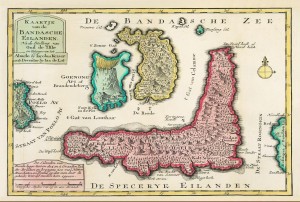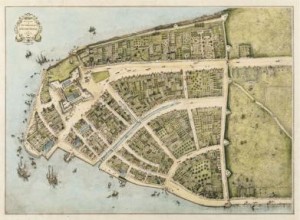For whatever reason, New York picked up the appellation ‘Big Apple’ – is it even appropriate? Unbeknownst to most people, and as a result of a remarkable twist in fate, the city’s fortunes actually owe far more to some exotic tropical spices in Indonesia than they do to the humble apple.
The spices in question are nutmeg and mace. Both come from the nutmeg tree, native to a tiny chain of islands called the Banda islands, which themselves are part of a larger group of islands called the Moluccas, or Spice Islands – a chain of islands in the vast Indonesian archipelago. Today, the Banda islands are largely forgotten and sometimes even omitted from maps of the region. But this common oversight belies their huge importance in times gone by, due to their indigenous nutmeg trees.
Although exotic spices from the Spice Islands had been traded for thousands of years, it was not until around the thirteenth century when they started to become popular in Europe. For 300 years up to around 1500, the Venetians dominated the European trade in nutmeg and mace – as well as other exotic spices from the Spice Islands such as cloves – since they controlled the Mediterranean seaways. Venice became very rich as these spices were in high demand in Europe and could attract astronomical prices. Nutmeg in particular was highly valued; the sweet-tasting spice was used as a hallucinogen and aphrodisiac. Meanwhile cloves, which have a distinctly pungent flavour, were revered for their medicinal properties. Not only did physicians believe they could cure the common cold and settle an upset stomach, but they could also improve poor eyesight!

The Venetians themselves obtained the spices from merchants in the Middle East, who kept their sources a closely guarded secret. But the Venetians’ monopoly could not last forever. Indeed, the potential rewards for discovering the source of these increasingly valuable spices provided a great incentive for European explorers to unravel the mysteries of the unexplored lands in the southern hemisphere. Portugal took a leading role in this respect, and in charting the route around the southern tip of Africa, accidentally discovered the coast of Brazil in 1500.
By 1511, a Portuguese fleet commanded by Alfonso de Albuquerque reached the strategically important port of Malacca on the Malaysian peninsula where the spices from the Spice Islands were brought to be traded. Among those on board was the legendary explorer Ferdinand Magellan, famous for later leading the first true circumnavigation of the globe, even though he didn’t actually make it back to Europe (he was killed in a brutal fight while trying to set up a trading post in the Philippines).
The Portuguese finally reached the Spice Islands in 1512. This was their pot of gold at the end of the rainbow: even when paying inflated prices for the spices to the local natives, they could still expect to reap profits of up to a phenomenal 1,000 percent when selling them back in Europe. The Portuguese were naturally ecstatic at their success, and to safeguard their newly found sources of riches from the competing Spanish, they built forts across the Molucca islands, many of which can still be seen today.
But the lucrative spice trade had also caught the attention of other European powers, most notably England and Holland. Although the Portuguese held onto the islands for a while after, the Dutch managed to wrest control of them by 1605. But the English hadn’t given up their aspirations either. Indeed, explorers from both countries made many attempts at identifying alternate routes to the Spice Islands. The arduous two-year journey east from Europe often ended in disaster, with ship crews decimated by scurvy and other deadly diseases.
One of the European explorers keen to locate the Spice Islands was Henry Hudson. Although English, he had been recruited by the Dutch. But after failing to find a northeast passage to Asia via the Arctic Ocean and North Pole in 1608, his ship sailed further east and ended up exploring the east coast of North America, even sailing for a distance up the Hudson River that now bears his name. He brought back news of fertile lands on his return to Holland, and the Dutch later sent more missions, eventually establishing a permanent presence in the area in 1614. Not long after, amid the threat of attacks by other European colonial powers, the Dutch constructed a fort to protect their trading post at the southern tip of what is today Manhattan. Little could Hudson have realised then the significance of his voyage to the Americas!

Meanwhile, in the Spice Islands, the Dutch had won the upper hand over the English. But even so, they did not have exclusive control over the Banda islands. Somehow, the English, under the resourceful and determined spice trader Nathaniel Courthope, had managed to establish a foothold on the tiny island of Run where they quickly erected forts to protect the island from the watchful Dutch.
However, the presence of the English on this island was a thorn in the side of the Dutch governor-general of the East Indies Jan Pieterszoon Coen – even though both sides were technically allies, united in their common hatred of the Spanish. By all accounts a ruthless and bloodthirsty man, he set his sights on sending his unwelcome British neighbours packing. This did not take him long. He quickly captured two English ships and ordered the British to surrender. Although Courthope refused the request, his courage did not get him far: he was shot while trying to flee from the Dutch some time later.
But in 1624 the Dutch went one step too far. On Ambon Island, the Dutch unfairly accused the entire contingent of English traders of engineering a mutiny. As was the fashion of the time, these unfortunate traders were soon beheaded after their confessions were drummed out of them through particularly outlandish methods of torture. News of the outrage soon filtered back to England, where there was a public outcry. Feelings ran so high for a time that the Dutch even had to recall their ambassador. But after much heated debate, the Dutch finally relented and agreed to hand back the island of Run to the English.
Nevertheless, the peace did not last long. By 1660 the English and Dutch had gone to war after the former passed the controversial Navigation Act that sought to protect England’s trade by requiring all goods imported to England to be carried on English vessels. Putting an end to the hostilities was the Treaty of Breda in 1667.
As part of the deal, the English agreed to give up their interest in the island of Run in exchange for the Dutch island of Manhattan in North America
Even though the English thought they got the better deal, they could not have imagined – even in their wildest dreams – that they were now in possession of what was to become the world’s most influential and important city. So, if anyone ever asks you about New York’s nickname, why not suggest that perhaps the ‘Sweet Nutmeg’ would be far more appropriate?




